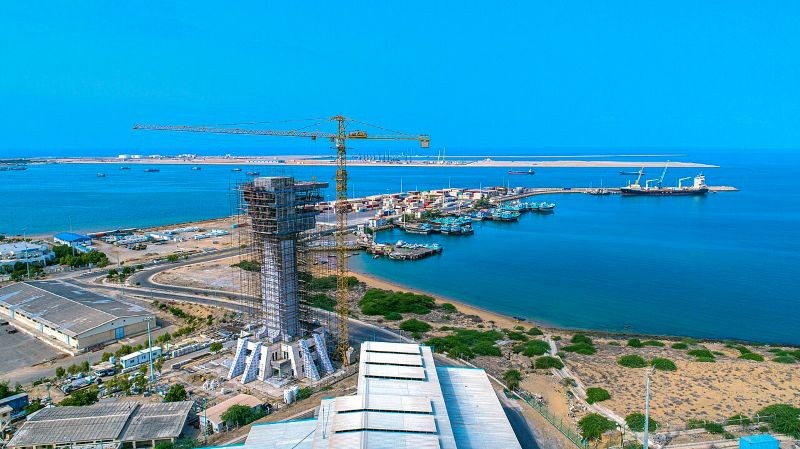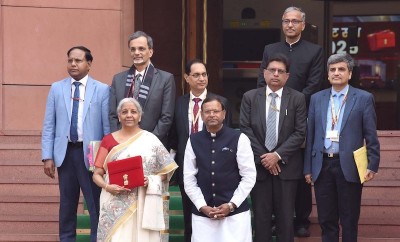 Chabahar port
Chabahar port
Tajikistan eyes Chabahar Port for expanded trade links with India
India’s vision for enhanced Eurasian connectivity is set to receive a major boost as Tajikistan begins discussions with Iran on utilizing the strategically significant Chabahar port.
The port, developed with India’s assistance, has been under New Delhi’s management since signing a landmark 10-year agreement with Tehran in 2024.
Tajikistan, eager to broaden its trade networks, is now exploring transit routes through Chabahar to strengthen economic ties with India and countries in the Gulf and Indian Ocean region.
Recent reports indicate that Tajikistan’s Transport Minister Azim Ibrohim and Iran’s Minister of Roads and Urban Development Farzaneh Sadeghi signed a Cooperation Program aimed at streamlining transit cargo movement via Chabahar.
Tajik authorities had earlier expressed interest in utilizing Iran’s Bandar Abbas port for transporting goods.
Since Tajikistan does not share a direct border with Iran, it plans to access Chabahar through either Uzbekistan and Turkmenistan or via Afghanistan, with the latter offering the shortest route.
Although relations between Tajikistan and the Taliban-led government in Afghanistan remain cautious, there has been a gradual effort to establish working ties.
The geopolitical dynamic between Tajikistan and Afghanistan adds complexity. Tajikistan houses the anti-Taliban National Resistance Front of Afghanistan (NRF), while Afghanistan has a significant Tajik population.
Despite the evolving relationship, Dushanbe remains wary of any security alliances that could align it with Pakistan’s agenda or directly support the current Kabul regime.
Tajikistan is not alone in its interest in Chabahar. Uzbekistan and Kazakhstan have also expressed intentions to leverage the port for trade, with Uzbekistan previously advocating for a trilateral agreement involving Iran and India to optimize Chabahar and the International North-South Transport Corridor (INSTC).
This development aligns with India’s diplomatic efforts to promote Chabahar as a critical trade hub. Recently, Indian Foreign Secretary Vikram Misri engaged with his Iranian counterpart and Afghanistan’s Acting Foreign Minister in Dubai to discuss maximizing the port’s potential.
Chabahar and the INSTC offer Eurasian nations a viable alternative to China’s Belt and Road Initiative (BRI), reinforcing India’s commitment to fostering regional connectivity and trade independence.
Tajikistan’s move to engage with Chabahar further underscores the port’s growing strategic importance in connecting Central Asia to global markets.
India’s relations with Central Asia is going to play a significant role in the geopolitics in the coming days. For India, Central Asia forms part of its extended neighbourhood.
India’s ability to fully leverage its strong historical and cultural ties with Central Asia has long been hindered by the absence of a shared land border. To overcome this geographic challenge, New Delhi has accelerated key initiatives aimed at strengthening trade and connectivity with the region.
Among the most significant projects are the International North-South Transport Corridor (INSTC) and the strategically important Chabahar port in Iran. Both initiatives have been in development for years but are now being fast-tracked to enhance India’s access to Central Asian markets and beyond.
The INSTC, a multimodal transportation network involving ship, rail, and road routes, aims to connect India to Russia and Europe via Central Asia and Iran.
Meanwhile, the Chabahar port, developed with India’s support, offers a direct sea-land trade route bypassing Pakistan.
Together, these projects are expected to play a critical role in boosting India’s trade links with Eurasia and providing the region with alternatives to China’s Belt and Road Initiative.
By prioritizing these connectivity efforts, India is signaling its commitment to deepening economic and strategic engagement with Central Asia and reducing dependence on traditional trade routes.
India’s historical ties with the Caucasus and Central Asia, rooted in centuries of trade, cultural exchange, and dynastic connections, continue to shape its ambitions in the region.
As global powers compete for influence in Eurasia, India is positioning itself as a key player by leveraging economic and diplomatic tools to strengthen its presence.
A centerpiece of India’s strategy is its 10-year agreement with Iran for the use of the Chabahar Port, a critical gateway for trade with Central Asia and beyond.
Complementing this effort, New Delhi is also negotiating a free trade agreement (FTA) with the Eurasian Economic Union (EAEU), underscoring its commitment to deepening economic ties with the region.
India is also exploring opportunities to expand cooperation in vital sectors, including raw materials, hydrocarbons, and agriculture.
The development of the International North-South Transport Corridor (INSTC), along with potential linkages to the Trans-Caspian International Transport Route (Middle Corridor), could further boost trade in textiles and other goods, areas long identified as priorities for Indian businesses.
Beyond traditional trade, India is looking to diversify its engagement with Central Asia through emerging sectors like healthcare and digital technology.
These areas hold significant potential for independent growth, irrespective of the pace of progress in infrastructure projects like the INSTC.
As New Delhi pursues its vision for a stronger foothold in Eurasia, its economic initiatives are poised to play a vital role in shaping the region’s development while offering a counterbalance to other global influences.
Support Our Journalism
We cannot do without you.. your contribution supports unbiased journalism
IBNS is not driven by any ism- not wokeism, not racism, not skewed secularism, not hyper right-wing or left liberal ideals, nor by any hardline religious beliefs or hyper nationalism. We want to serve you good old objective news, as they are. We do not judge or preach. We let people decide for themselves. We only try to present factual and well-sourced news.







